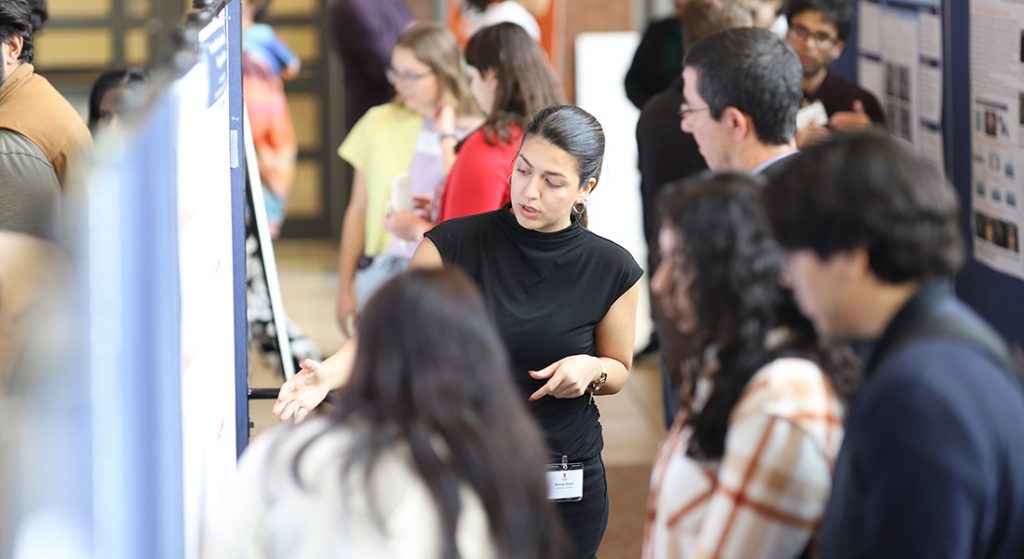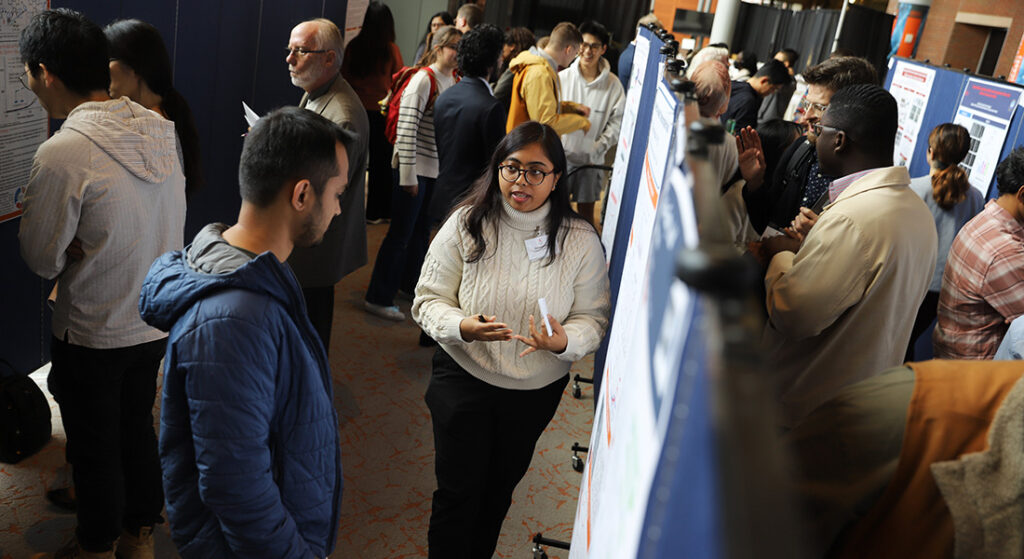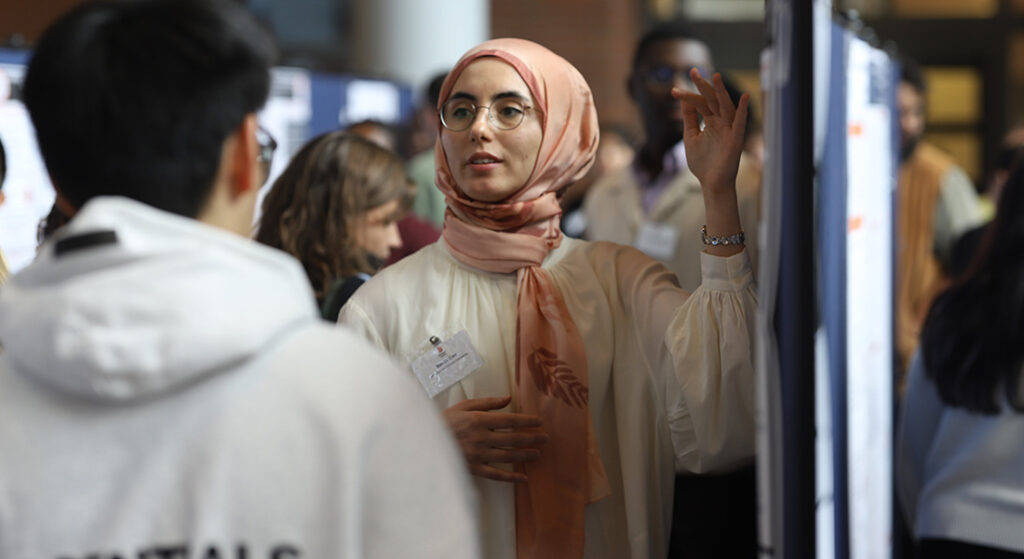The BioInspired Institute’s third annual research symposium was held Oct. 24-25, bringing together undergraduate and graduate students, postdoctoral scholars and faculty from Syracuse University, SUNY Upstate Medical University and SUNY College of Environmental Science and Forestry, along with other regional research and industry partners.

Doctoral student Cijun Zhang explains his research to BioInspired Symposium attendees. Zhang studies in the Xiaoran Hu functional organic materials lab.
The event featured poster presentations by 79 undergraduate and graduate students and postdoctoral scholars. Several researchers presented “lightning talks” on topics such as how diseases develop and how the human body reacts; fabricating and creating smart materials; and new technologies to address problems from clean energy to robotics to medicine. Guest speakers from several universities made special presentations. Awards were presented to recognize researchers in multiple ways.
Three recipients were chosen in the Best Overall Poster category:
- Yuming Jiang ’25, a dual mathematics and physics major in the College of Arts and Sciences (A&S), for “Competitive Protein Ligand-Protein Receptor Interactions Using Queueing Models.” (Principal investigators are Liviu Movileanu, physics professor, and Antun Skanata, research assistant professor of physics.)
- Tyler Hain, a doctoral student in physics in A&S, for “Optimizing Properties on the Critical Rigidity Manifold of Underconstrained Central-Force Networks.” (Principal investigator is Lisa Manning, William R. Kenan Jr. Professor of Physics.)
- Anna Hinman, an M.D./Ph.D. student in cell and developmental biology at SUNY Upstate Medical University, for “Role of a Novel Zinc Finger Protein in Morphogenesis of the Zebrafish Left-Right Organizer.” (Principal investigator is Jeffrey Amack, associate research professor of biology.)
Two presenters were recognized as Stevenson Biomaterials Poster Award winners:
- Thalma Orado, a biomedical and chemical engineering doctoral student in the College of Engineering and Computer Science (ECS), for her work on “Mechanochromic Polyurethane Shape Memory Polymers for Application in Surveillance of Infections in Chronic Wounds.” (Principal investigator is Mary Beth Monroe, associate professor of biomedical and chemical engineering.)
- Yanbing Tang G’21, a mechanical and aerospace engineering doctoral student in ECS, for “Soft Shells with Artificial Defects for Robust Manipulation.” (Principal investigator is Wanliang Shan, associate professor of mechanical and aerospace engineering.)
Two researchers received awards recognizing Best Lightning Talks:
- Amber Ford, a doctoral student in chemistry in A&S, whose topic was “GOAT-ing for an Improved Cancer Biomarker: Ligand-Conjugate Development Targeting Ghrelin O-Acyltransferase.” Her work involves testing to find an improved diagnostic biomarker for prostate and other cancers. (Principal investigator is James Hougland, professor and director of biochemistry.)
- Anna-Blessing Merife, a doctoral student in biomedical and chemical engineering in ECS, for her research on bone tissue, described in “Calcium Signaling Reveal Insight into Mechanoadaptation of 3D Osteocyte Networks in Oscillating-Collagen Models under Pulsatile Unidirectional Fluid Flow Stimuli (PUFFS).”(Principal investigator is Pranav Soman, professor of biomedical and chemical engineering.)
A project by Sevde Can, “Smart Foams Tackle Wounds: Vanillic Acid-Incorporated Shape Memory Polymer Foams for Hemorrhage and Infection Control,” was recognized as having the best commercialization potential. Can is a biomedical and chemical engineering doctoral student in ECS. (Principal investigator is Mary Beth Monroe.)
Receiving honors for her “social impact” initiative was Kiana Memaran Dadgar, G ‘22, an assistant teaching professor in the School of Architecture, for her work, “IMPACT: Empowering Architecture Students through Interdisciplinary Mentorship in Sustainable Material Innovation.” The project explored an interdisciplinary collaboration between the University’s Departments of Chemistry and Architecture that aimed to foster societal impact through sustainable innovation in architectural materials. (Her collaborator was Davoud Mozhdehi, associate professor of chemistry in A&S.)

Winner of the People’s Choice Award was Ernest Obeng, a biomedical and chemical engineering doctoral student in ECS. His project, “Antimicrobial Hemostatic Shape Memory Polymer Foams for Infection Prevention in Traumatic Wounds.”
His research examines how hemostatic materials with antibacterial and antibiofilm properties can reduce infection rates and enhance the healing of traumatic wounds. (Principal investigator is Mary Beth Monroe.)
Best Publication Awards went to:
- Andrew Kowalczewski G’22, a graduate of the School of Information Studies’ applied data science program who is now a doctoral student in bioengineering and biomedical engineering in ECS. He is exploring the use of hiPSC-CMs to study and understand cardiomyocyte biology through biology with artificial intelligence. His paper, “Design Optimization of Geometrically Confined Cardiac Organoids Enabled by Machine Learning Techniques,” published in Cell Reports Methods in June, presented new methods for investigating the physiological functioning of cardiac organoids using machine learning algorithms.
- Thai Le Ba Nghia, a doctoral student in bioengineering at ECS, studies wound healing and tissue regeneration. His paper, “Chitosan Poly(vinyl alcohol) Methacrylate Hydrogels for Tissue Engineering Scaffolds,” was published in the journal ACS Applied Biomaterials in February.
- Michael Patrick Seitz, a doctoral student in bioengineering at ECS, received an honorable mention. His paper, “Soft Polyethylene Glycol Hydrogels Support Human PSC Pluripotency and Morphogenesis,” was published in the journal ACS Biomaterials Science and Engineering in June.



